
Weather in May
Temperature
The initiation of May sees an average high-temperature of a still hot 31°C (87.8°F), showing minor variations from the previous month. Male's nocturnal average in May closely mirrors its daytime temperatures, settling at a warm 26.2°C (79.2°F).Heat index
The heat index value during May is evaluated at a scorching 41°C (105.8°F). Take additional safety steps, risk of heat exhaustion and heat cramps is notable. Prolonged activity may cause heatstroke.Be aware that heat index ratings are designed for shaded locations and minor breezes. Direct sunlight exposure may result in a rise of the heat index by 15 Fahrenheit (8 Celsius) degrees.
Note: The heat index, also known as 'real feel' or 'feels like', joins air temperature with relative humidity to produce a temperature perception for humans. Depending on the activity and the individual's heat perception, which may vary due to factors including wind, clothing, and metabolic variations, this effect remains subjective. Keep it in mind, direct sunlight can augment the heat you experience, possibly pushing the heat index up by 15 Fahrenheit (8 Celsius) degrees. Heat index values are highly critical to babies and toddlers. Children typically face more danger than adults as their sweat production is usually lower. Additionally, the bigger skin surface compared to their small size and the increased heat due to their activeness exacerbate the risk.
The human body normally cools itself by perspiration. Excessive warmth is eliminated from the body by evaporation of sweat. When relative humidity is heightened, it slows the rate of evaporation, thereby decreasing the body's ability to shed heat and creating a sensation of overheating. If heat absorption exceeds the body's cooling ability, body temperature can elevate, resulting in potential thermal illnesses.
Humidity
In Male, the average relative humidity in May is 80.8%.Rainfall
In May, in Male, the rain falls for 14.3 days. Throughout May, 216mm (8.5") of precipitation is accumulated. In Male, during the entire year, the rain falls for 130.7 days and collects up to 1949mm (76.73") of precipitation.Sea temperature
In May, the average sea temperature in Male is 29.6°C (85.3°F).Note: Swimming, diving, and other water activities in the temperature range of 25°C (77°F) to 29°C (84.2°F) are perceived as very enjoyable and comfortable for prolonged durations.
Daylight
The average length of the day in May is 12h and 19min.On the first day of the month, sunrise is at 05:54 and sunset at 18:11. On the last day of May, sunrise is at 05:53 and sunset at 18:14 +05.
Sunshine
In Male, the average sunshine in May is 7.2h.UV index
January through May, August through November, with an average maximum UV index of 12, are months with the highest UV index. A UV Index estimate of 11, and higher, represents an extreme threat to health from unsafe exposure to UV radiation for the average person.Note: An average UV index of 12 in May transforms into this advice:
Enforce every vital precaution. Those with light skin could endure burns in a matter of minutes. Remember that the sun's UV radiation is strongest between 10 a.m. and 4 p.m. Make an effort to avoid direct sun exposure during these hours. Arm yourself against UV rays' harm with protective apparel and UV-filtering shades. Directly after swimming or an outdoor workout, generously apply and reapply a broad-spectrum SPF 30+ sunscreen. Take note! Sand and water reflections strengthen the Sun's UV exposure.
Frequently asked questions
How hot is May in Male?
What is the average humidity in May in Male?
How much does it rain in Male in May?
What is the water temperature in May in Male?
How many hours of daylight does Male have in May?
When is the sunrise / sunset in May in Male?
How long on average sun shines in May in Male?
What are the months with the highest UV index in Male?
What is the UV index intensity in May in Male?
Average temperature in May
Male, Maldives
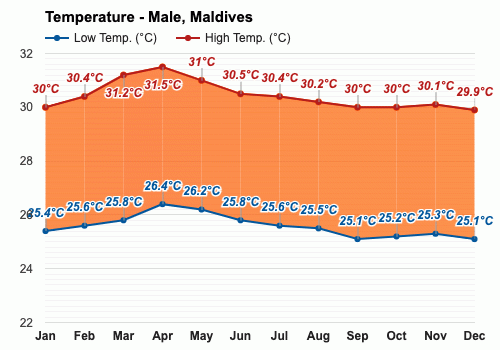
- Average high temperature in May: 31°C
The warmest month (with the highest average high temperature) is April (31.5°C).
The month with the lowest average high temperature is December (29.9°C).
- Average low temperature in May: 26.2°C
The month with the highest average low temperature is April (26.4°C).
The coldest months (with the lowest average low temperature) are September and December (25.1°C).
Average humidity in May
Male, Maldives
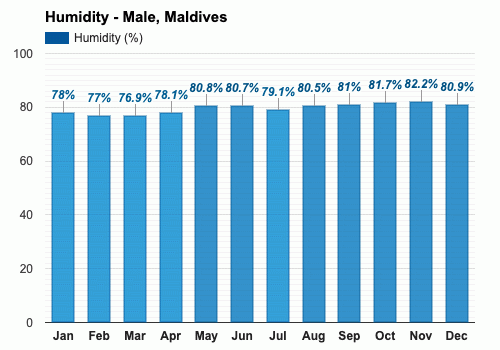
- Average humidity in May: 80.8%
The month with the highest relative humidity is November (82.2%).
The month with the lowest relative humidity is March (76.9%).
Average rainfall in May
Male, Maldives
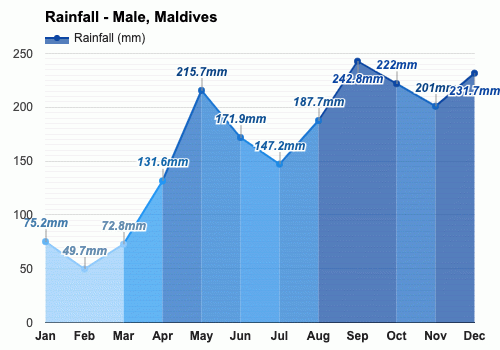
- Average rainfall in May: 215.7mm
The wettest month (with the highest rainfall) is September (242.8mm).
The driest month (with the least rainfall) is February (49.7mm).
Average rainfall days in May
Male, Maldives
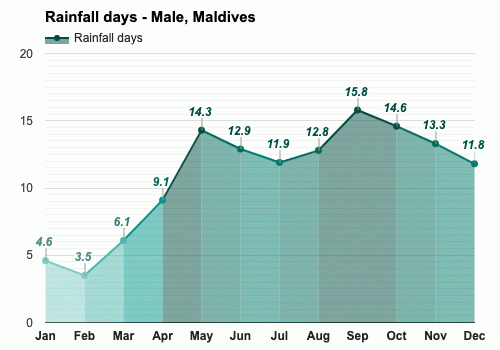
- Average rainfall days in May: 14.3 days
The month with the highest number of rainy days is September (15.8 days).
The month with the least rainy days is February (3.5 days).
Average sea temperature in May
Male, Maldives
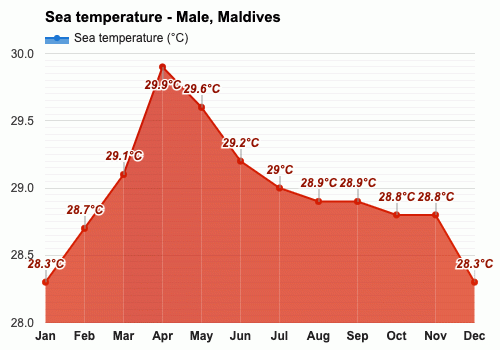
- Average sea temperature in May: 29.6°C
The best month for swimming (with the highest average sea temperature) is April (29.9°C).
The coldest months (with the lowest average sea temperature) are January and December (28.3°C).
Average daylight in May /
Average sunshine in May
Male, Maldives

- Average daylight in May: 12h and 2min
The month with the longest days is June (Average daylight: 12h and 24min).
The month with the shortest days is December (Average daylight: 11h and 54min).
- Average sunshine in May: 7h and 1min
The month with the most sunshine is February (Average sunshine: 9h and 18min).
The months with the least sunshine are June and September (Average sunshine: 6h and 42min).
Average UV index in May
Male, Maldives

- Average UV index in May: 12
The months with the highest UV index are January, February, March, April, May, August, September, October and November (UV index 12).
The months with the lowest UV index are June, July and December (UV index 11).
Male, Maldives
Weather forecast for your location
2. Allow the app to use your location


